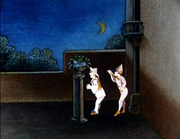
Théâtre Optique
Encyclopedia

Charles-Émile Reynaud
Charles-Émile Reynaud was a French science teacher, responsible for the first projected animated cartoon films....
in 1892. It was the first presentation of projected moving images to an audience, predating Auguste and Louis Lumière
Auguste and Louis Lumière
The Lumière brothers, Auguste Marie Louis Nicolas and Louis Jean , were among the earliest filmmakers in history...
's first public performance by three years.
History
In 1876, Reynaud, a FrenchFrench people
The French are a nation that share a common French culture and speak the French language as a mother tongue. Historically, the French population are descended from peoples of Celtic, Latin and Germanic origin, and are today a mixture of several ethnic groups...
inventor, had created the Praxinoscope
Praxinoscope
The praxinoscope was an animation device, the successor to the zoetrope. It was invented in France in 1877 by Charles-Émile Reynaud. Like the zoetrope, it used a strip of pictures placed around the inner surface of a spinning cylinder...
, an improvement of the Zoetrope
Zoetrope
A zoetrope is a device that produces an illusion of action from a rapid succession of static pictures. The term zoetrope is from the Greek words "ζωή – zoe", "life" and τρόπος – tropos, "turn". It may be taken to mean "wheel of life"....
. The Praxinoscope replaced the narrow viewing slits of the Zoetrope with an inner circle of 12 mirrors (equal to the number of images), allowing a clearer and less distorted view of the moving image. Several people could watch the performance at the same time. After Reynaud licensed his invention in 1877, it sold well in a number of the large Paris
Paris
Paris is the capital and largest city in France, situated on the river Seine, in northern France, at the heart of the Île-de-France region...
department stores.
In 1878 Reynaud produced the Praxinoscope Theatre. This improved version included a glass viewing screen which allowed the moving image to be superimposed over a changeable background. He continued to improve the design and in 1880 created the first projection version. The Projection Praxinoscope used a lantern to project the moving images onto a small screen, allowing a larger audience to view it, but was still limited to 12 images.


Musée Grévin
The Musée Grévin is a waxwork museum in Paris located on the Grands Boulevards in the IXe arrondissement on the right bank of the Seine, at 10, Boulevard Montmartre, Paris, France. It is open daily; an admission fee is charged....
in Paris
Paris
Paris is the capital and largest city in France, situated on the river Seine, in northern France, at the heart of the Île-de-France region...
. The show, billed as Pantomimes Lumineuses, included three cartoons, Pauvre Pierrot
Pauvre Pierrot
Pauvre Pierrot is an 1892 French short animated film directed by Charles-Émile Reynaud. It consists of 500 individually painted images and lasts about 15 minutes....
, Un bon bock
Un bon bock
Un bon bock is an 1892 French short animated film directed by Émile Reynaud. It consists of 700 individually painted images and lasts about 15 minutes....
, and Le Clown et ses chiens
Le Clown et ses chiens
Le Clown et ses chiens is an 1892 French short animated film directed by Émile Reynaud. It consists of 300 individually painted images and lasts about 15 minutes...
, each consisting of 500 to 600 individually painted images and lasting about 15 minutes. Reynaud acted as the projectionist and the show was accompanied by a piano player. Although the films shown by the Lumière Brothers in 1895 eclipsed it, the show stayed at the Musée Grévin until 1900 by which time over 500,000 people had seen it.

